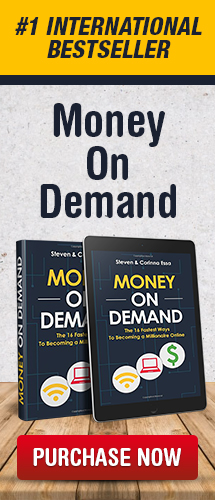“Video is going to be the next big thing on the Internet” we often say.
When I first introduced the concept of selling with webinars at a conference in London back in 2009, no one in the room had ever heard of that strategy.
At that same conference, a few speakers mentioned tele-conferencing as a means to sell products. However, with the introduction of high-speed Internet, it was obvious to me that video conferencing was going to take over.
A few months later, I received an interesting message from the seminar promoter of that event, who said,
Never before have I seen people become so successful as a result of a speaker’s talk.
The months that followed the conference were very interesting. Testimonials came pouring in from people from all walks of life. They had tried different strategies over the years without experiencing consistent results, and they shared how many sales they had been able to generate thanks to webinars… in a very short space of time.
The new ‘web-conferencing’ technology that internet marketers are now using, was, until recently, only available to large corporations at a cost of $100,000+ a year.
Thanks to the introduction of high-speed broadband internet, the price of video-conferencing technology has continued to drop, and people can now present webinars for up to 1,000 people at the same time, for just a few s a month!
The show-and-tell method is a very effective way to leverage your time. A webinar allows you to present to hundreds—or even thousands—of people at a time from anywhere in the world. In addition, the typical conversion rate of a show-and-tell webinar is 10 per cent (compared to websites which usually convert at 1 per cent.)
In other words, expect your webinar to convert one sale for every ten people who attend. If you are selling a $297 product, and 100 people are watching your webinar, expect to make 10 sales, if not more.
In addition, webinars allow you to sell high-ticket offers priced at $1,000 to even $10,000, whereas it can be challenging to sell products for more than $200 directly from a website.
Putting together a webinar — step-by-step
- Ensure your Internet connection has an upload speed of at least 600- 700kbps. Speedtest.net is a great tool to use before presenting any live webinar, to check your Internet
- Buy a quality headset that includes a microphone and a mute button. The most popular one used on webinars is currently ‘Logitech H390 USB headset’. This ensures that any background noise is removed, and should you be interrupted during the webinar for any reason—or feel the need to cough or clear your throat—you can simply click on the “mute button”.
- Devise a catchy title, also known as a “marketing hook”.
It is important for the title to grab the attention of your target audience by giving them a big promise.
The title of your webinar will make or break the attendance rate of your event.
Examples of marketing hooks:
- Attention natural health practitioners: How to double your client base for free, thanks to the internet
- The little-known secrets to be back-pain-free naturally in 30 days
- The 7 natural remedies for arthritis
- Attention career women: 5 steps to getting the man of your dreams
- How to look 20 years younger naturally
- Select the topic of your webinar
- Is your idea/topic grounded in personal experience? If it is, conveying your story on your webinar will give you all the social proof you need to convince people they should listen to you.
Do you have passion or expertise in that field? Enthusiasm is contagious, so never present a webinar on a topic that you are not familiar with or have no particular interest in.
- Understand who your target audience is.
Is it targeted towards a healthy market? It’s important that the target audience for your webinar has spending power, and is used to spending money in that particular field.
- Come up with a great introduction
The first 10 or 15 minutes of a show-and-tell webinar is very important. Make sure that the introduction covers the following topics:
- Identify who the webinar is for.
For example, imagine you’re presenting a webinar on weight loss, titled How to lose up to 5 pounds in 30 days and keep it off for good. It’s important you state specifically who the webinar is for. Based on the title, you might think the answer is obvious, but reiterating in more detail who the webinar is for enables the viewers to identify themselves. The more you describe your target audience in detail and touch on their pain and challenges, the more they’ll feel understood. This will impact sales. You should say something like,
This webinar is for you if you’re a woman over 40 who has tried different diets over the years but as soon as you lose weight, you put it on again.
Or,
“This webinar is for you if you would like to lose weight but don’t have time to hit the gym.”
This is important because you want as many people as possible to say to themselves,
“Great! This is for me, that’s what I’ve been looking for.”
- Describe who you are and why you’re sharing this information.
“Why should I listen to you?” is a very common question and it’s important that the first ten or fifteen minutes of the webinar answers it. Include as much evidence as you can that you have experience in the field. Show how you have achieved significant results yourself as a result of implementing the strategy that is about to be revealed in this webinar. This will establish that much-needed trust. And trust is a vital component for closing sales.
- Explain why the audience will benefit from this webinar.
To ensure your audience stays engaged throughout the whole presentation, make sure you whet their appetite with what’s about to come. For example, don’t give everything away by saying,
“I’ll show you that eating six small meals a day will make you lose weight fast without ever feeling hungry.” It’s best to keep a level of mystery by saying,
“I’ll reveal how you can eat more and still lose weight so you never feel hungry.”
- Make sure you structure the content in 3, 5 or 7 steps.
It’s important that the content flows well, so the viewer feels you’re taking them from point A (not knowing anything or knowing very little about the topic) to point B (having a clear understanding of how they can achieve the results promised in the title.)
For example, the structure of your presentation could be:
Step 1: Set a goal and deadline
Step 2: Identify your bad eating habits
Step 3: Clear your fridge
Step 4: Prepare your weekly eating plan
Step 5: Keep a food diary
- Illustrate the steps with stories and case studies.
Try to include in each step a story or case study to illustrate each point made. For example, talk about how your client, Lucy, identified that one of her bad eating habits was skipping meals because she didn’t enjoy the meals provided at work. As soon as she realized that was making her store fat, she prepared her own lunch boxes and as a result lost five pounds in 30 days.
The more you include stories and case studies, the easier it will be for your audience to digest the information and remain engaged. Too often, presenters treat webinars as tutorials or lectures, which is the fastest way to lose your audience’s interest!
- Introduce your product or service.
To transition smoothly from the content to the selling, it’s important to announce you’re about to offer an opportunity for people to go further faster. A smooth transition could look like:
“If you’ve enjoyed this presentation and would like to learn more about how you can implement this strategy right now, I’ve put together a program called, The weight loss fast track formula.
Alternatively, your transition could be,
“I’ve delivered priceless information to you, right? But if you haven’t followed this system before, it could be a little overwhelming, right? Is it ok if I share with you how you can achieve your weight loss goals the fast and easy way?”
In the example above, you’re simply asking permission to introduce your offer.
Case Study: Annette Densham
Annette Densham had never heard of the SpeedCash: Show-and-tell method prior to attending one of our seminars. She had been dragged to the seminar reluctantly, by a friend.
At 43, She had recently been made redundant from a 6-figure job and was working for $20 an hour. She had 20 years of experience working in public relations and was looking for different options to turn her life around.
At the seminar, we conducted a competition, where attendees were asked to share their ideas for a chance to be coached one-on-one to implement the SpeedCash: Show-and-tell method.
Annette Densham won the competition. Her idea was to show people how to write a press release to get featured in the media. We turned her idea into a webinar titled How to get a million dollars worth of free publicity.
In less than 90 minutes, she showed the audience how anyone needing more customers could tap into the power of the media for free. She then sold a $497 information course on how to implement her strategies.
This resulted in $5,000 worth of sales in just under 90 minutes.
What’s more, Annette hadn’t even created the product yet!
Annette now travels around Australia delivering her presentation at major networking events and mastermind groups, and has secured high-paying monthly clients who subscribe to her services as a result of this strategy.




Well done again Steven with great info. Thanks for being my mentor and advisor. On only my 3rd webinar following your system I made 7 sales worth $ 3,479.00. And 1 more sale a few days later from the replay.
Webinars are now are a huge part of my business
WOW Mark, well done mate. That’s fantastic. I knew it was only a matter of time with you. SUPERSTAR performance my friend.
Are you In Dubsi
Hi Linda, I live on the Gold Coast in Australia. But I speak in Dubai from time to time.
Are you coming to Dubsi
Hi Linda, We have no bookings for Dubai at this stage but we will let you know if/when we are coming.
When is the seminar